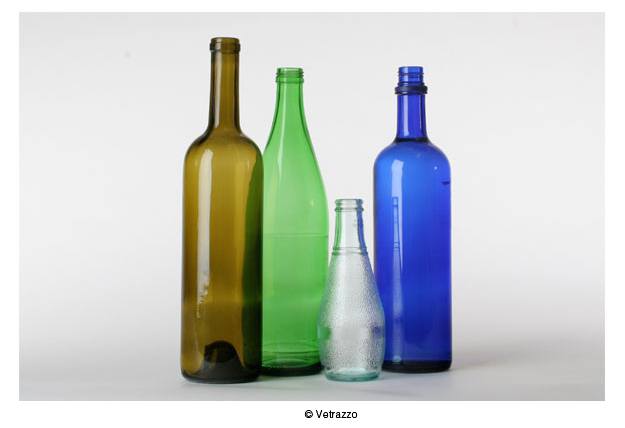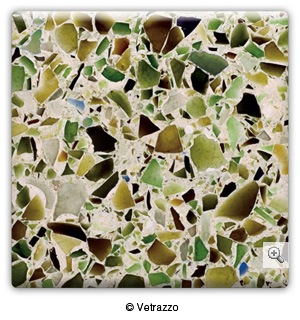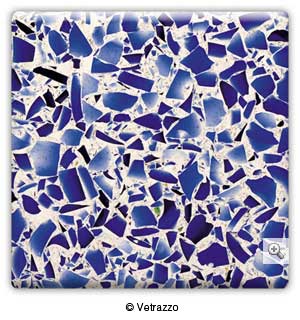Fabulous design. Cutting edge looks. Interesting twists in color, fabric, and texture. These are all elements inherent in design that's ecologically sound. Yes, your creativity can have free reign even as you make choices that help protect the planet. Increasingly, manufacturers are creating products that have minimal impact on the environment, whether because they're made from organically-grown cotton or because they're made with renewable resources. We think environmentally friendly design is so important that we recently added a Green Design lesson to the NYIAD Complete Course in Interior Design.
In our "Decorating Green" column we'll look at a sustainable, low-impact element of design in each issue of "Designer Monthly." We hope these articles will help us all help the planet and the many creatures that share it with us.
IceStone and Vetrazzo

Remember when you were a kid, and you’d search the summer shoreline for glass that had been rubbed smooth by the sea and spit back out onto the sand? Sea glass, we called it, and it was a prize, worth, in trade, several perfect seashells or a really pretty rock with a white line running through it.
Now, Green design has brought something of that idea back to us: bits of colored broken glass embedded in cement and transformed into countertop and flooring surfaces used for the kitchen and bath.
As you’re probably aware, there are several elements that are considered in Green design. One is that you want to use recycled materials as much as you can, so that you’re not making demands on the earth’s resources in the creation of your home. Another factor is to consider the long-run, and to use materials that will themselves break down easily and won’t just sit in a landfill for a couple of thousand years.


These surface materials such as IceStone have a variety of differently colored bits of broken glass to give it its shine and color. The effect is a very pretty, smooth material that has a depth to the colors and in which the different shades blend and mix. And it uses glass products that otherwise would be sitting in the landfill for the next generations.
The concrete base of the countertop is designed to decompose when you’re done with the countertop, so you don’t have to worry about your grandchildren’s grandchildren inheriting it.


But another aspect of Green design is more immediately about the people involved. First, does the product emit chemical gasses after installation which can harm the inhabitants of the home? And second, are people exploited, or is their health put in jeopardy, in making the product?
With Green countertops, the fabrication process is designed to eliminate the dangers of the chemicals associated with many other kinds of building materials.


As companies dedicated to Green design blossom, they are tending to also pay attention to the way they treat their employees. In many parts of the world, including the U.S., there are still many people who work in punishing conditions with dangerous materials and equipment. But the new Green design companies give us hope that one day sweatshops will be a thing of the past.



On either end of the United States there sit two such companies which are dedicated not only to creating fully Green countertops, but also to treating their employees in a way that enhances their lives: Vetrazzo, based in Berkley, California, and IceStone, based in Brooklyn, New York.
Vetrazzo offers full benefits to its employees, and, according to the company, pays 50% higher wages than other area manufacturing jobs. “Workers enjoy natural light, safety equipment that goes well beyond what is mandatory, and a continuing education program. Vetrazzo believes this investment in their people produces highly motivated workers, greater retention, and a top-quality product,” according to the company.
On the east coast, IceStone provides a similar model. Their Mission Statement includes sentiments found more often in a yoga studio or psychotherapy practice than in a manufacturing plant. Their mission regarding employees is “To apply their passion, creativity, and skills to the work we do. To learn and grow in mind, body and spirit. To honor the balance between work and family.” IceStone also offers continuing education classes to their employees, including free classes in English as a Second Language, something deeply needed by many laborers in the U.S. Not bad for a place that’s also creating beautiful, sustainable materials that use discarded glass.

Both these companies have won Green design awards, and have participated in design shows. But the ultimate test is whether or not you love the way the stuff looks. The thought of the glass shards used in these Green countertops isn’t quite as romantic as the sea glass of childhood---if you look closely, you can see how indeed the caramel-brown comes from old beer bottles. But even that has a romance to it, if you think about how, by buying the product, you are doing your part in helping preserve the ocean and all the creatures that live there.
And it really is a beautiful product. This is a material that looks alive, as opposed to the old Formica countertops. Any time you use a living material, even if it’s trapped inside something as inanimate as a countertop, you can tell the difference. Just think of how different a plastic table feels as opposed to a wood one, even though the wood was long ago cut from its roots in the forest.
The same is true with recycled glass countertops: because the glass is mixed in throughout the concrete base, it’s got a rich, deep complexity that’s a pleasure to look at, and that goes beyond the superficial layer.
If you run your hand along the countertop, take a deep breath, and close your eyes, you can think you’re at the beach, rubbing a piece of seaglass between your fingers.







